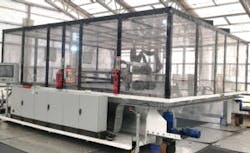Just as wireless communications and edge computing enable mobile applications, they also allow other functions to join in.
For instance, to 3D print aluminum-titanium coatings more quickly onto the decks and other large surfaces of two of its aircraft carriers, the U.K.’s Royal Navy and its service engineering firm recently worked with Platinum Electrical Engineering and Schneider Electric to build a robot-on-wheels that could apply the coatings in three, high-temperature steps at the required dimensions and throughput to create landing and takeoff capabilities for the F35 lightning fastjet, which wasn’t possible with traditional flight-deck coatings.
Located in Newcastle, U.K., Platinum is a system integrator and engineering, procurement and construction (EPC) firm that developed the 7 x 7 x 4 meter, four-wheel-drive, four-wheel steer, fully autonomous vehicle, which includes a multi-axis, linear robot arm from Schneider’s division in Germany.
“This mobile, 3D-printing robot uses a laser-based alignment system, which determines distances and positions, indexes application areas, detect obstacles, and avoid tiedowns and other deck equipment other,” says Stephen Maltby, managing director at Platinum. “Its servos and other devices communicate via multiple methods, and directly access onboard PLCs, such as Modicon LMC058 for motion control, via three protocols including Sercos, Modbus and CANbus.”
Stickier with SCADA
The Queen Elizabeth- and Prince of Wales-class carriers were launched in 2018, so the mobile robot was enlisted to apply the improved, better-adhering coatings after the vessels entered service. More recently, the 3D-printing vehicle also upgraded from its standard PLC-to-robot communications and controls to an onboard supervisory control and data acquisition system (SCADA) for real-time production data.
Likewise, Maltby reports that Platinum implemented Aveva software for contract wine bottler Greencroft Bottling Co. in Durham, U.K. These packages include Aveva Mobile Operator for connecting workforce software, and Aveva Insight that interacts with online historians. They collaborated with Schneider’s Twido PLCs and software to monitor Greencroft’s blending, large-container operations and process lines, and receive data from its enterprise resource planning (ERP) system.
“We can link all assets across Wi-Fi and PLCs to Aveva Insight,” explains Maltby. “This lets us know task statuses, flag equipment, pull up overall equipment effectiveness (OEE) records, show quality checklists, and display individual test results for mobile operations.”
Simplify with standard library blocks
To further shorten the bridges between data sources, Platinum also beta tested Schneider’s Ecostruxure Automation Expert software, which works with the IEC 61499 standard that defines domain-specific modeling language for distributed controls, and employs UniversalAutomation.Org’s (UAO) shared runtime engine that provides open connectivity. IEC 61499 and UAO let users create portable environments for open architectures, and develop software without having to consider what hardware it will run on.
“Previously, device-to-device links required adapters to convert protocols, so users had to consider architectures, including processor sizes, PLC connections and connectors, before thinking about what code they wanted to use,” says Maltby. “IEC 61499 and UAO are vendor-agnostic, so users can develop code immediately because all the devices they’ll use speak the same language—no matter where the data processing load is located.”
Beyond saddling CPUs with fewer conversion tasks, IEC 61499 and UAO also means those microprocessors and their functions no longer have to sit on PLCs alone, but can instead run on PCs, generic silicon boards like a Raspberry Pi, devices from other vendors, or simply run as software on virtualized, operating system (OS)-level tools like Docker containers. “In the early 2000s, PLCs could be monsters. We had projects where we had to delete code because a microprocessor memory was filled with code, even in the highest specification PLC,” explains Maltby. “Now, we can consider operating tasks and code first. We’ve only scratched the surface of this capability. The future of automation can combine process and power, and also looking beyond to artificial and business intelligence that’s placed directly in the control layer or at the edge.”
Because it’s also a function-based asset library, Ecostruxure Automation Expert contains composite automation types (CAT) for pump stations, HMIs, connectors and other assets, which comply with IEC 61499 and UAO, and can be employed to build applications more easily. “CATs have the traditional function blocks and code for process control assets, such as HMI faceplates and their documentation,” adds Maltby. “These are the basics for managing and controlling physical assets, and organizing them in a hierarchy with single-line diagrams (SLD) to design the plant layout. Aveva’s engineering software can be directly linked to Ecostruxure Automation Expert to provide added design tools and system support. If they’re used at the engineering stage, users can create their hierarchies by starting with P&IDs or their SLDs. In our experience, we estimate we’ve saved 40% on our engineering time by using CATs and the customizable function blocks in the library.”
Once users sketch out a function such as a valve or pump, and pick a control hierarchy, Maltby reports they can use Ecostruxure Automation Expert’s CATs to visualize those controls on an HMI based on their initial P&ID, and use Ecostruxure Automation Expert to connect directly to Aveva’s SCADA software to push information and reports to enterprise levels, allowing further and deeper integration with other process functions.
“We’re assembling the same elements as we did in the past, but now we’re more synched and seamless,” he explains. “The most benefit comes when the control staff wants to do testing. Because the libraries in Exostruxure Automation Expert have predetermined graphics and faceplates alongside control philosophies for specific asset types in a single development environment (SDE), they no longer have to ask the pump, service, documentation and other teams separately, and can get input from all of them and can do their testing in one place. Previously, it took a half hour to call in requirements for each individual area, and it could take a day for one person to verify individual outcomes. Now, testing is much quicker; we just tell the system to synch, and we’re done in 5-30 minutes. That’s how we’re saving so much engineering time.”
Algae information via MQTT
In one of its latest assignments, Platinum is contributing to a project that’s using nutrient-rich seawater to cultivate local algae strains in a southern province of Morocco located in the Sahara Desert. These algae can reportedly consume 30 times as much CO2 as an equivalent amount of forest, but the process was mostly in life-sciences labs. Consequently, the client’s Innovate UK-funded effort seeks to modularize, expand the process exponentially, and establish other sites worldwide.
Platinum has worked with one of the oceanographic sensor manufacturers to allow data to be published via MQTT directly to Aveva Insight, where the data is shared with Aveva System platform, and passed to the control system to make changes in operations. These sensors measure light wavelengths, but they needed to adopt a standard communications method, so they were upgraded to publish data via the publish-subscribe MQTT protocol and HiveMQ’s platform. They’re also employing an IEC 61499-based engine to use data from different sources for a common purpose without having to depend on one type of hardware.
“This project is still at the pilot and testing stage, but we’re already gathering information for the scale-up phase,” says Maltby. “This is possible because a big chunk of the automation and control work is already done in the testbed at the research facility, and it’s about 40% ahead on engineering time, too.”
This is part four of Control's January/February cover story mini-series. Read the other installments here.
About the Author

Leaders relevant to this article:


